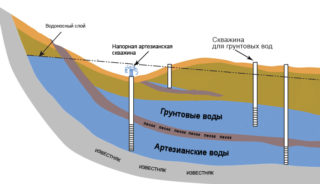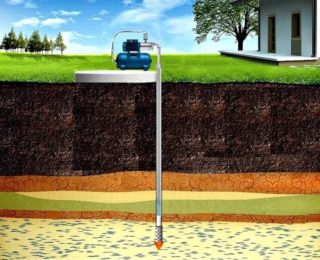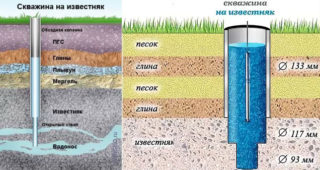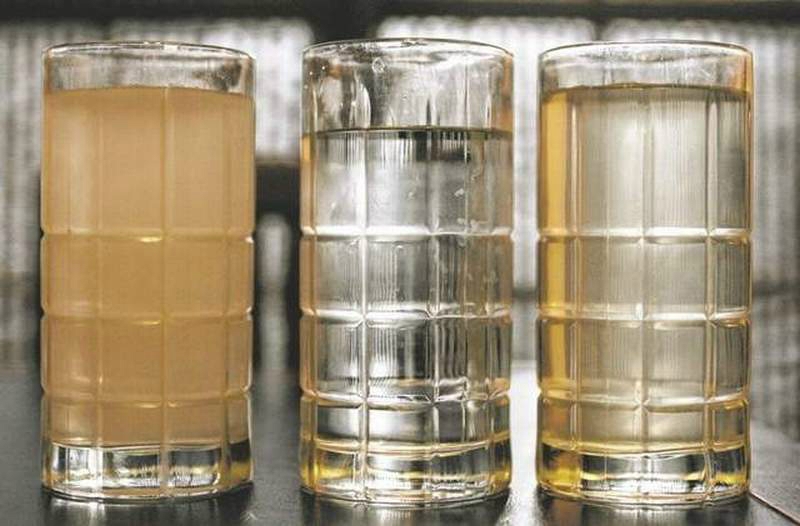Water supply through well drilling is widespread in many remote areas. When arranging it on a private site, you have to solve many technical and organizational problems. There are several ways to solve them. When choosing the best option, it is required to solve the question of how water wells are classified, taking into account specific conditions.
Classification of aquifers
The following main types of aquifers are distinguished:
- Verkhovodka. This is the name of the water carriers located close to the surface of the earth (2-7 m). These are limited volumes of unconfined water surrounded by impermeable layers (for example, clay). The liquid in them is, as a rule, of precipitation and flood nature. The nature of the accumulation is seasonal. The main advantages of such sources are: shallow burial depth, the possibility of lifting without a pump, low costs when drilling wells. Main disadvantage: poor water quality. The natural filter is thin and is not able to completely purify the liquid. Various chemical compounds may be present in it, and therefore water is intended for technical purposes. Can be used for drinking only after additional cleaning and boiling. Another disadvantage is a decrease in flow rate (up to a complete cessation of water supply) in the hot season, as well as seasonal instability.
- Primer. The first permanent aquifer in the form of groundwater is located at a depth of 6-22 m. Such a layer is located between the water-resistant layers or is limited only by the lower water-resistant layers and can reach significant sizes. It is formed as a result of sediment seepage and infiltration from water bodies. The water carrier can be of the pressurized or non-pressurized type. In the first case, the water is under pressure in it. The groundwater table can undergo seasonal changes, decreasing in summer. Advantages: easy accessibility and ease of lifting to the surface. Water can be safely used for any household needs, but before drinking or using it for cooking, filtration and boiling are required.
- Interstratal water carriers. These are water reservoirs, plugged between two water-resistant strata. They are located at a depth of 25-75 m and are always under pressure (pressure type). With independent emergence to the surface, interstratal accumulations are created by springs. The main advantage is the purity of the water. You can drink it. Disadvantages: deep burial, drilling difficulties, increased costs for well completion. Due to the presence of constant pressure, water is able to rise independently to a certain height. If it is not enough to reach the surface, then it becomes necessary to install pumping equipment.
Important! Interstratal deposits located at a depth of more than 80-100 m are usually called artesian layer. They are characterized by constant, increased pressure. The reservoir level is constant. The water is drinkable without any additional purification. Such a well is expensive to drill and operate.When drilling, various problems can arise associated with the passage of particularly hard and difficult areas.
Varieties of wells
The task of the well is to connect the water carrier with the water consumer. An exploration well is drilled to determine the depth of the water layer and its parameters. The reduction in the cost of work is achieved by using drills of reduced diameter. When developing a top water, it is enough to install a drill with a diameter of 10 cm, for deeper deposits - 20 cm. The depth is determined using special probes.
Abyssinian well
The main advantages of the wells under consideration: low costs, the possibility of self-production, the speed of construction, the ability to install almost anywhere (even in the basement of the house). The service life is estimated at 25-35 years. Among the disadvantages, the following is noted: the impossibility of equipment on particularly hard ground, a surface pump can be used only at a depth of no more than 6 m.
Sand hole
A filter well is drilled during the development of a sandy aquifer located at a depth of 40-45 m. It is drilled with the help of special equipment and immediately equipped with a casing to prevent wall shattering. For the column, metal, plastic or concrete pipes with a diameter of 13-20 cm are used. A filter is installed in the lower part. The rise of water is provided by a submersible pump.
Advantages of a well for sand: use for drilling small-sized equipment, which reduces costs; you can install a low-power pump; a well is drilled in 1-2 days. Disadvantages: low productivity (up to 2 cubic meters / h), dependence of water quality on many factors and its instability, dependence of the water level on the season.
Limestone wells
The advantages of artesian wells: high purity of water, a constant level of occurrence of a water carrier, increased productivity (up to 9-10 cubic meters / h), durability (more than 40 years). Disadvantages: increased costs for drilling and equipment, production time (5-8 days), the need for a site for the operation of large-sized equipment.
Choosing a well for a site
When asked which well will be optimal for a particular site, it is necessary to determine the parameters of the water carrier, take into account the need for water and financial capabilities. An Abyssinian well can be equipped by any person on his site, and without any approvals. It will be cheap, but the water will be technical. A purification plant is needed to turn it into a drinking one.
An artesian well provides quality drinking water, but is very expensive. As a rule, it is drilled to serve several sites, or even an entire village. In addition, for the arrangement of such a well, special permission from the relevant authorities is required.
The most widespread are sand wells.They optimally combine water quality, productivity and drilling costs. They can be arranged by one owner of the site or several owners. Drilling does not require large equipment and is carried out at any site by specialized companies. Permits are not required.











